Twenty-five kilometers north of Taitung City along Highway 11, which marks the shoreline of Taiwan’s scenic southeast coast, lies an odd yet charming village.
The short stretch of mom-and-pop shops and sprinkling of backpackers’ inns with colorful signage does not serve a morsel of food during the slow season.
“We’re out of ingredients,” a shop owner says. “We only serve drinks and dessert.”
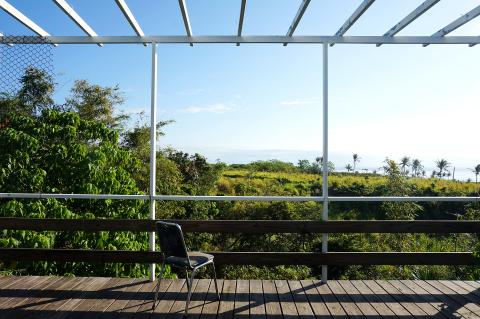
Photo: Dana Ter, Taipei Times
“It depends if the chef feels like cooking today,” says another.
Finally, a kind restaurateur takes pity on me when I tell him I’m famished. But as I whip out my camera, poised to capture the rare delicacy, he places a miserable burrito the size of a name card in front of me. I devour it in three bites.
FEEL THE BEAT

Photo: Dana Ter, Taipei Times
If the inhabitants of Dulan Village (都蘭) are not being nourished by food, then it’s the music and arts scene that’s sustaining them.
The roaring mountains and black sand beaches are home to Amis Aborigines, as well as a growing number of bohemian expats and hipster Taiwanese. The vibe is akin to untapped Polynesian enclaves in Hawaii. Except you’ll be lucky to see more than a lone fisherman out at shore. Whatever infrastructure there is, it’s away from the coast. The nearest access point to the beach is a good half hour trek down a rocky dirt road.
Dulan is a different sort of subtropical getaway — one where you wake up at sunrise to the sounds of people singing in the mountains, their voices softly syncing with the waves lapping and roosters crooning. Throughout the day, earthy-sounding music intermixing lyrics in Hoklo (more commonly known as Taiwanese) and the Amis language drifts out from the windows of the Sugar Factory (新東糖廠), a cluster of ramshackle warehouses in an old sugar plantation revamped into an arts and culture center with live music.
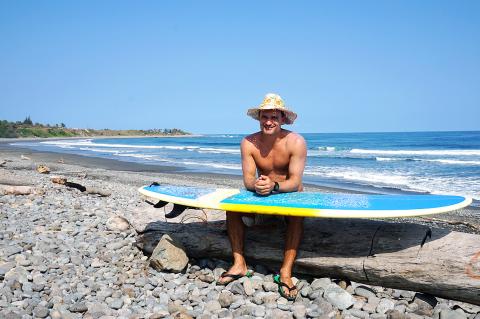
Photo: Dana Ter, Taipei Times
We’re on scooters without helmets earlier this month, coasting along a winding road to the Sugar Factory.
Referring to Amis songs, recording artist Wang Chi-san (王繼三) says, “I felt a different kind of energy emanating from their music.”
His recording studio is a little wooden-boarded room on the second floor of the factory. Remotes and wires are strewn all over teal-colored desks and endless stacks of CDs loom on shelves looking like an unfinished jenga game. Wang, who is Taipei-born and raised, was introduced to Amis culture when he met Aboriginal singers visiting the city.
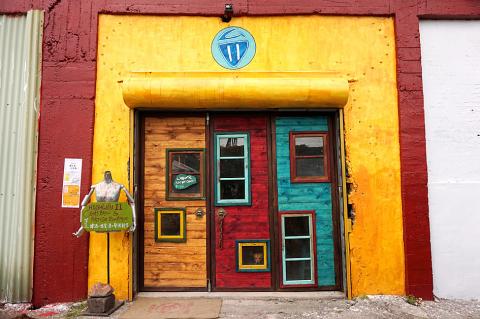
Photo: Dana Ter, Taipei Times
“I previously thought that technique was something that was taught in school,” Wang says. “But Aboriginal people learn how to sing by listening to their grandparents.”
Wang was inspired by their music so much that he packed his bags and drove down to Dulan three years ago despite protests from his wife, who refused to step out of the car when they first arrived.
“When Aboriginal singers enter a commercial studio, they lose their ability to sing. The studio manager might steer them in the wrong direction and misunderstandings ensue,” Wang says.
By contrast, he wants artists to feel at home in his recording studio. While his wife was making peace with Dulan, Wang was busy drawing up the design plans for the studio. The space is meant to be different than the ones he worked at in bigger cities. And it shows. Despite the sound proof walls, an airy feel permeates. Wisps of palm trees are also subtly visible from the ceiling windows.
If “dilapidated chic” isn’t a catch phrase yet, it should be. The rest of the Sugar Factory is a musician’s dream — drum sets and keyboards are scattered all around, sound boxes are hooked up to power outlets with multicolored wires and busted holes in the walls are converted into stairwells rather than being patched up. Regular musicians who jam at the factory have their own desks, although there’s a communal working space on the second floor where they brew coffee and enjoy locally-grown tomatoes (so that’s where the food is).
Wang and his 10-person team spent the last two years scouting musicians and putting together an album of Amis-language children songs.
“It was difficult because nothing here is organized — there is no such word for that,” he says.
The album’s importance is underscored by the fact that dialects were not allowed to be spoken during martial law. In a way, the songs are a means of re-introducing to Amis children their mother language and culture.
Wang says it’s his way of giving back. “I wanted to try something different, something where the entire concept is about the music itself, not economics,” he says.
FINE-TUNING
A 10-minute walk from the Sugar Factory is Talaluki’s garage-turned-workshop. The heavy slabs of driftwood he collects are piled along the driveway at the end of a row of cheery single-story houses, waiting to be turned into hand-carved guitars. A friend of Wang’s, Talaluki frequently jams at the Sugar Factory. But his workshop is his sanctuary. Talaluki, who hails from the Amis tribe in Hualien, writes his name (which means “bat” like the animal) on everything. Not only is it glued onto his guitars, but it’s also scribbled on masks and water bottles.
“My wish is that people in Taiwan and around the world will see the brand Talaluki and recognize that the guitars were made by an Aboriginal artist in Dulan,” he says.
Sawed-up pieces of driftwood and heavy-duty tools are scattered on tables and shelves and we have to navigate them to enter his workshop. Talaluki shows me his guitars which are displayed against the walls. Consisting of different shapes, colors and sizes, some resemble electric guitars, while others look more like ukuleles.
Talaluki has been making guitars since he was in junior high, but his parents were adamant about him finding a “real” job in the city. After 20 years of working at art galleries and photography studios across Taiwan, he took a leap of faith by moving to Dulan and starting his current business.
“Eventually, my mother visited me and was [overjoyed] when she saw my guitars,” Talaluki says.
It’s still a one-man operation. From hauling driftwood from the beach to the final product, one guitar takes three months to assemble. Talaluki’s dream is to expand the workshop into a thriving business and employ a couple of carvers. He would then sell the guitars to music shops around Taiwan. It would not only provide job opportunities for Aboriginal people, but also keep Amis culture alive.
“This is our culture. We are a culture that sings. But if I don’t sing, no one will,” he says.
Talaluki says he wants to set an example for Dulan’s Aboriginal youth because they are repeatedly told that they are incapable of achieving anything great in life. Their own communities internalize this mentality and children grow up thinking they are not smart enough or skilled enough to do certain things.
“My purpose isn’t to become famous or make a lot of money,” he says. “It’s to better my community and to show Aboriginal children that they can accomplish great feats.”
WHERE THE BREWS AT
Back at the Sugar Factory in a colorful warehouse by a giant smokestack, a different type of craft is brewing.
“Beer in moderation, social activism to the extreme,” quips Brian Curan.
Originally from California, Curan arrived 14 years ago and has since been living in Dulan on and off with a six-year absence in between when he and his wife traveled the world. Curan brews his beer from home and brings them to Highway 11 Craft Beer which he opened earlier this year. His hoppy ales are displayed alongside his wife’s paintings and handmade crafts.
“It’s fun to make the stuff on my own and give out samples to people to get a feel of which ones they like,” Curan says. (The lemon wheat ale is delicious.)
Like his friends Wang and Talaluki, Curan has dreams of expanding his business. He currently sells his beer to local bars, but Highway 11 has yet to become a full-fledged brewery. Curan hopes that it will be more than just a place to kick back and enjoy some beers though.
“I would like the brewery to also be a site that generates money for social causes and hosts activist meetings,” he says.
Curan is involved in a local protest group called Fan Fan Fan (反反反), which means “oppose, oppose, oppose.” They hold regular meetings around Taitung County to organize protests against commercial developments such as massive-scale hotels that they think will adversely affect the county’s natural environment.
“This is the last pristine area of Taiwan, the last bastion. People come here for that,” Curan says.
ALL THE SAME
A few blocks away from the Sugar Factory, Curan’s surfer friend Mark Jackson offers a different perspective. Jackson, a 12-year Dulan resident from South Africa who runs Wa Ga Li Gong (哇軋力共) surf hostel, a popular hangout spot for artsy types, says that locals should decide their own future.
“When I speak to local Aboriginal kids,” he says, “they’re not saying ‘let’s protect the beaches.’ They’re asking, ‘where’s my next video game?’”
He adds that there’s no beach culture. “It’s video game culture.”
Jackson says martial law made it nearly impossible for parents to take their children to the beaches for weekend outings. As a result of never playing in the water or building sand castles when they were young, people grew up thinking that the beach was a dangerous place. But surfing, he adds, is helping to make the water more appealing.
Jackson, who tends makes films when he’s not giving surf lessons, is set on incorporating the beach as an important motif in his work. The inspiration for Archipelago, a series of short documentary films about Dulan-based artists, musicians and surfers came from Playing for Change, a multimedia music project conceived in 2002 that compiled tracks from artists around the world performing the same song in their own style.
“We didn’t need to fly around the world because we had the world in Dulan,” Jackson says.
Archipelego is comprised of songs sung in six or seven different languages including Japanese, Spanish and Amis, which is then overlaid with various instruments such as guitars and drums. Parts of it were recorded in Wang’s studio in the Sugar Factory.
“I wanted to show how music, art and surfing are interrelated in Dulan,” Jackson says.
“I liked the metaphor of our blood and ocean both being salty — it doesn’t matter where you’re from, our blood is the same, just like the ocean,” he adds.
It takes a special kind of person to live in this tiny bohemian village. Art is nourishment to its entrepreneurial inhabitants who hail from all corners of the earth. Without their dedication, Dulan wouldn’t be what it is.
IF YOU GO
Getting there:
■ Take the express train from Taipei Main Station (台北火車站) to Taitung Station (台東火車站), train ride takes three and a half hours
■ Take a taxi (NT$650) or bus (NT$58) from Taitung Station to Dulan. The ride is approximately 30 minutes, but buses are infrequent
■ Scooters are the best way to travel within Dulan, most shops rent for NT$400 a day
Useful Web sites:
■ Talaluki driftwood guitars: www.facebook.com/Talaluki
■ Wa Ga Li Gong: wagaligongtaiwan.com
Where to stay:
Budget:
■ Wa Ga Li Gong (哇軋力共): scooter rental for NT$400 a day, including board rack, surfboard rental (NT$400 to NT$700) and surf lessons (NT$1,500 each for one to two persons)
■ Dulan 102 (都蘭102): www.facebook.com/Dulan102
Mid-range:
■ Lehuo Shoudu Moli Inn (樂活首都茉莉民宿): lehuo.ttbnb.tw/about.htm
■ Nanbali Inn (南八里民宿): nanbali.travel123.tw
What to bring:
■ Lots of food

The unexpected collapse of the recall campaigns is being viewed through many lenses, most of them skewed and self-absorbed. The international media unsurprisingly focuses on what they perceive as the message that Taiwanese voters were sending in the failure of the mass recall, especially to China, the US and to friendly Western nations. This made some sense prior to early last month. One of the main arguments used by recall campaigners for recalling Chinese Nationalist Party (KMT) lawmakers was that they were too pro-China, and by extension not to be trusted with defending the nation. Also by extension, that argument could be
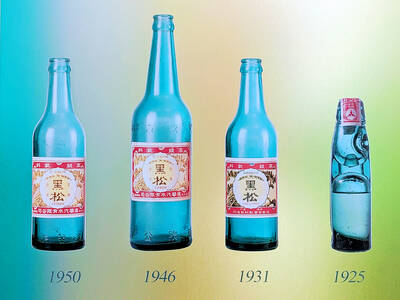
Aug. 4 to Aug. 10 When Coca-Cola finally pushed its way into Taiwan’s market in 1968, it allegedly vowed to wipe out its major domestic rival Hey Song within five years. But Hey Song, which began as a manual operation in a family cow shed in 1925, had proven its resilience, surviving numerous setbacks — including the loss of autonomy and nearly all its assets due to the Japanese colonial government’s wartime economic policy. By the 1960s, Hey Song had risen to the top of Taiwan’s beverage industry. This success was driven not only by president Chang Wen-chi’s

Last week, on the heels of the recall election that turned out so badly for Taiwan, came the news that US President Donald Trump had blocked the transit of President William Lai (賴清德) through the US on his way to Latin America. A few days later the international media reported that in June a scheduled visit by Minister of National Defense Wellington Koo (顧立雄) for high level meetings was canceled by the US after China’s President Xi Jinping (習近平) asked Trump to curb US engagement with Taiwan during a June phone call. The cancellation of Lai’s transit was a gaudy
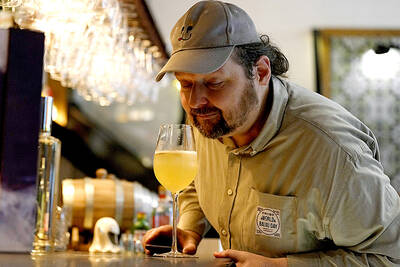
The centuries-old fiery Chinese spirit baijiu (白酒), long associated with business dinners, is being reshaped to appeal to younger generations as its makers adapt to changing times. Mostly distilled from sorghum, the clear but pungent liquor contains as much as 60 percent alcohol. It’s the usual choice for toasts of gan bei (乾杯), the Chinese expression for bottoms up, and raucous drinking games. “If you like to drink spirits and you’ve never had baijiu, it’s kind of like eating noodles but you’ve never had spaghetti,” said Jim Boyce, a Canadian writer and wine expert who founded World Baijiu Day a decade